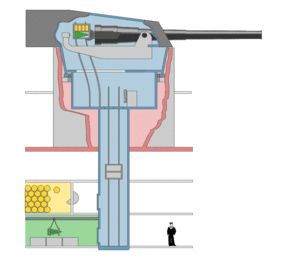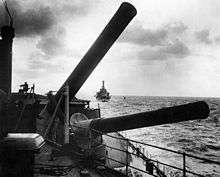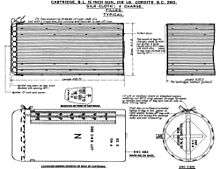BL 15 inch Mk I naval gun
| BL 15 inch Mark I | |
|---|---|
|
As mounted on monitor HMS Terror, 1915 | |
| Type | naval gun |
| Place of origin | United Kingdom |
| Service history | |
| In service | 1915-1959 |
| Used by | United Kingdom |
| Wars | WWI, WWII, Cold War |
| Production history | |
| Designed | 1912 |
| Manufacturer | see text |
| Produced | 1912-1918 |
| Number built | 186 |
| Specifications | |
| Weight | 100 long tons (100 t)[1] |
| Length | 650.4 inches (16.52 m)[1] |
|
| |
| Shell | separate charges and shell |
| Shell weight | 1,938 pounds (879 kg) |
| Calibre | 15-inch (381.0 mm) |
| Recoil | 46 inches (1.2 m)[1] |
| Rate of fire | 2 rounds per minute |
| Muzzle velocity | 2,458 feet per second (749 m/s) |
| Maximum firing range | 33,550 yards (30,680 m) (Mk XVIIB or Mk XXII streamlined shell @ 30°)[2] HMS Vanguard - 37,870 yards (34,630 m) @ 30°, with supercharges. |
The BL 15 inch Mark I succeeded the 13.5-inch (340 mm) gun. It was the first British 15 inch (381 mm) gun design and the most widely used and longest lasting of any British designs, and arguably the most efficient heavy gun ever developed by the Royal Navy. It was deployed on capital ships from 1915 until 1959, and was a key Royal Navy gun in both World Wars.
Design
This gun was an enlarged version of the successful BL 13.5 inch Mk V naval gun, specifically intended to arm the new Queen Elizabeth-class battleships as part of the British response to the new generation of Dreadnought battleships Germany was building during the naval arms race leading up to World War I. The normal slow and cautious prototype and testing stages of a new gun's development were bypassed, and it was ordered straight from the drawing board due to the urgency of the times. In the event it met all expectations and was a competitive battleship main armament throughout both World Wars. According to an American report produced after World War II, the British 15 inch Mk I was the most reliable and accurate battleship main armament of the war, though other guns and mountings had superior individual features.[3]
The barrel was 42 calibres long (i.e., 15 in x 42 = 630 in) and was referred to as "15 inch/42". This wire-wound gun fired a 1938 lb (879 kg) Mk XVIIB shell at a muzzle velocity of 2,458 ft/s (749 m/s).[2]
The battlecruiser HMS Hood had its Mk I guns in a unique mounting, designated Mk II. Incorporating experience from the Battle of Jutland, the Mk II mounting had a maximum elevation of 30°, thus increasing the maximum range.[4] In the 1930s a modification of the Mk I mounting, designated the Mk I (N), was introduced for use in those capital ships that were completely reconstructed. The Mk I (N) mounting also increased the maximum elevation from 20° to 30°.[5] Maximum range in shipboard mountings was 33,550 yards (30,680 m) (30° elevation).[2] During World War II older battleships with gun elevation limited to 20° were supplied with supercharges to increase their maximum range to 29,930 yards (27,370 m) at 2638 ft/s (804 m/s) using the Mk XVIIB or Mk XXII projectile, while HMS Vanguard could range to 37,870 yards (34,630 m) while using supercharges at a gun elevation of 30°.[2] Coastal artillery mountings with higher elevations could reach 44,150 yards (40,370 m). The firing life of a 15 inch gun was approximately 335 full charge firings using standard charges, after which it had to be re-lined.[6]
Usage
In battle
The BL 15 inch Mark I gun proved its effectiveness at the Battle of Jutland in 1916, scoring hits out to 19,500 yards, a record for naval gunnery at that time.[7]
In World War II the gun was responsible for the longest range shell-hit ever scored by one battleship on another in combat. At the Battle of Calabria on 9 July 1940, HMS Warspite gained a hit on the Italian battleship Giulio Cesare with her first salvo at 26,400 yards.[8]
Warships
These guns were used on several classes of battleships from 1915 until HMS Vanguard, the last battleship to be built for the Royal Navy, completed in 1946.
Warships with the BL 15 inch Mark I gun:
- Queen Elizabeth-class battleships (Five ships with eight guns each - 3 ships converted to Mk I (N))
- Revenge-class battleships (Five ships with eight guns each)
- Renown-class battlecruisers (Two ships with six guns each - 1 ship converted to Mk I (N))
- HMS Hood - battlecruiser (Eight guns, Mk II mounting)
- Courageous-class battlecruisers (Two ships with four guns each)
- Erebus-class monitors (Two ships with two guns each)
- Marshal Ney-class monitors (Two ships with two guns each)
- Roberts-class monitors (Two ships with two guns each)
- HMS Vanguard - battleship (Eight guns in mountings taken from Courageous and Glorious converted to Mk I (N), with additional armour, designated: Mk I (N) RP12)
Coastal batteries
- Two coastal guns ("Clem" and "Jane") were mounted near Wanstone Farm in Kent in the 1940s, and were used extensively for cross-Channel fire throughout the war.
- Five guns were mounted in Singapore at Johore battery and Buona Vista Battery in the 1930s.
 |
 |
 One of Singapore's 15 inch coastal defence guns elevated for firing |
Production

186 guns were manufactured between 1912 and 1918.[9] They were removed from ships, refurbished, and rotated back into other ships over their lifetime.
- Elswick Ordnance Company, Elswick, Newcastle: 34
- Armstrong Whitworth, Openshaw, Manchester: 12.
- William Beardmore & Company, Parkhead, Glasgow: 37
- Coventry Ordnance Works, Coventry: 19
- Royal Gun Factory, Woolwich: 33
- Vickers, Son and Maxim, Sheffield: 49
Two guns, one formerly from HMS Ramillies (left gun) and the other originally mounted in HMS Resolution, but later moved to HMS Roberts (right gun), are mounted outside the Imperial War Museum in London.
World War II ammunition
 |
 |
.jpg) |
 |
See also
Weapons of comparable role, performance and era
- 38 cm SK L/45 "Max" - German counterpart
- Cannone navale da 381/40 : Italian counterpart
References
Bibliography
- Burt, R. A. (2012). British Battleships, 1919–1939 (2nd ed.). Annapolis, Maryland: Naval Institute Press. ISBN 978-1-59114-052-8.
- Buxton, Ian Lyon (1978). Big Gun Monitors. Tynemouth: World Ship Society. ISBN 0-905617-06-1.
- Campbell, John (1985). Naval Weapons of World War II. Annapolis, Maryland: Naval Institute Press. ISBN 0-87021-459-4.
- Raven, Alan; Roberts, John (1976). British Battleships of World War Two: The Development and Technical History of the Royal Navy's Battleship and Battlecruisers from 1911 to 1946. Annapolis, Maryland: Naval Institute Press. ISBN 0-87021-817-4.
- Roskill, Captain Stephen Wentworth (1974). H.M.S. Warspite: The Story of a Famous Battleship. London: Futura Publications. ISBN 0-86007-172-3.
External links
| Wikimedia Commons has media related to BL 15 inch Mk I naval gun. |
- Information at Naval Weapons website
- HMS Vanguard site
- The IWM guns
- Images from the Vickers Photographic Archives
- "Closing the breech of a 15 inch gun at Explosion!" The Museum of Naval Firepower, Gosport, UK on YouTube
- Terry Gander, Twentieth century British coast defence guns
